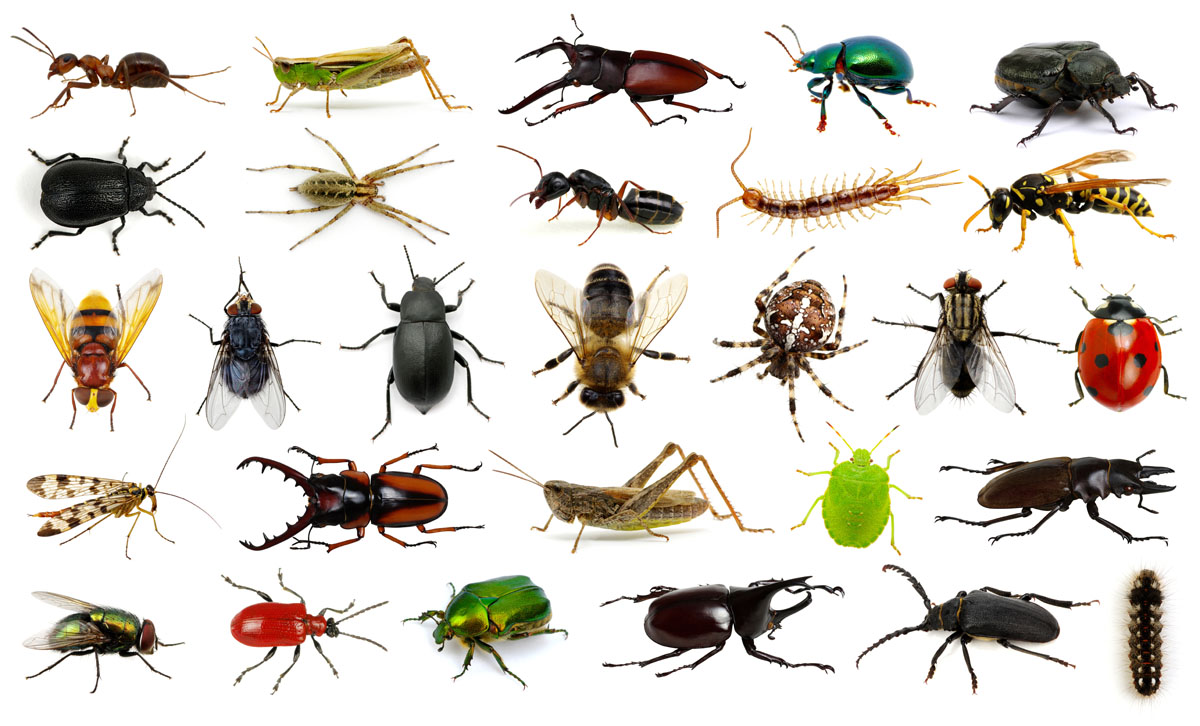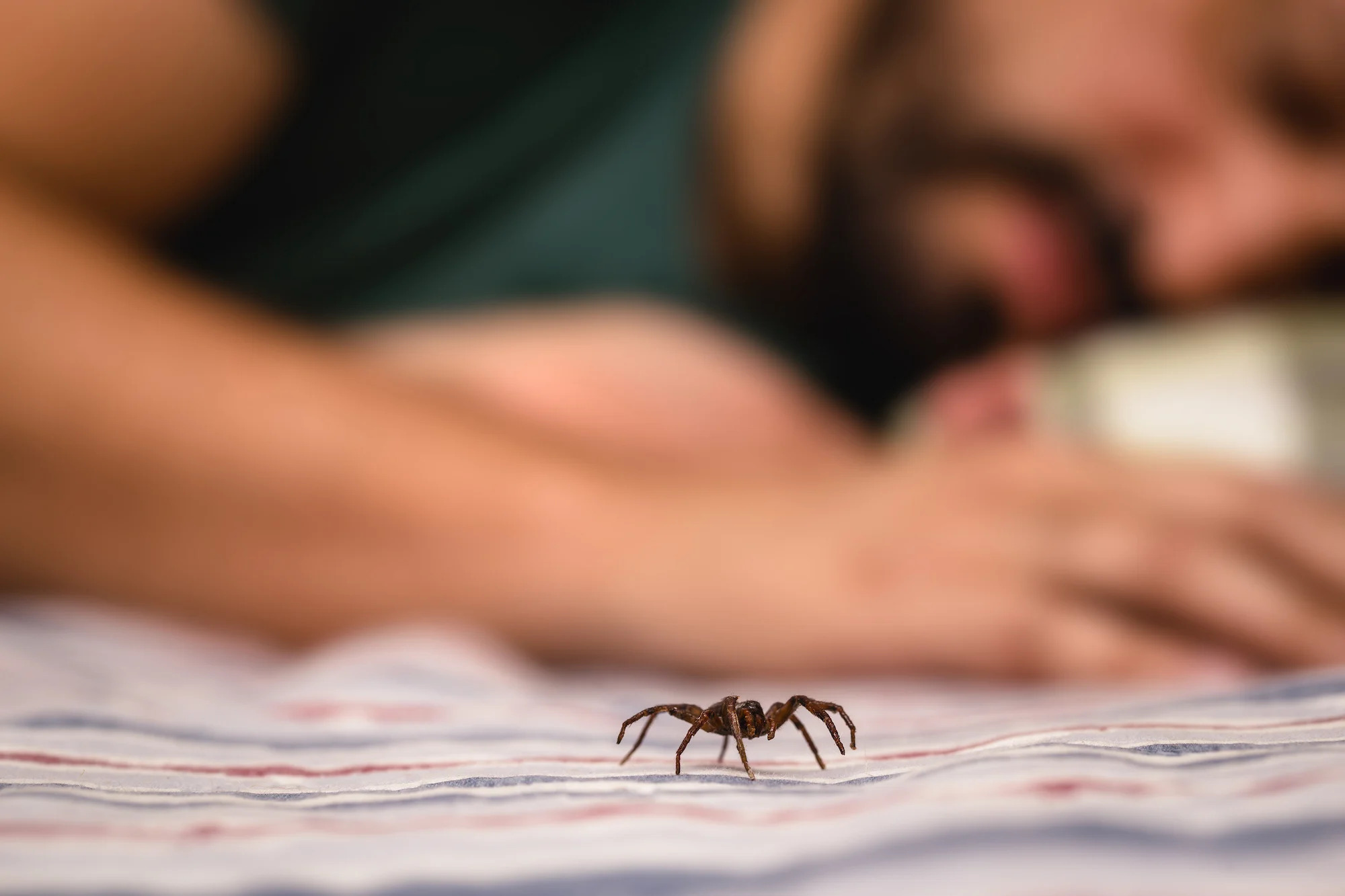Home>Gardening News and Trends>Latest News>How Many Species Of Insects Are There As Of 2017?


Latest News
How Many Species Of Insects Are There As Of 2017?
Modified: January 22, 2024
Get the Latest News on the Number of Insect Species in 2017. Discover the fascinating world of insects and learn about the staggering diversity they bring to our planet.
(Many of the links in this article redirect to a specific reviewed product. Your purchase of these products through affiliate links helps to generate commission for Chicagolandgardening.com, at no extra cost. Learn more)
Table of Contents
Introduction
Insects are a diverse and fascinating group of organisms that play a crucial role in our ecosystem. With their incredible variety and abundance, they are often referred to as the most successful group of organisms on earth. In fact, scientists estimate that there could be millions of insect species yet to be discovered and named.
The study of insects, known as entomology, has been a subject of interest for centuries. Scientists and researchers have dedicated their efforts to understanding these creatures and their ecological significance. In recent years, there has been a growing interest in determining the exact number of insect species that exist.
Knowing the total number of insect species is not only a matter of scientific curiosity but also has significant implications for our understanding of biodiversity and conservation efforts. Insects are vital for maintaining ecosystems and provide various ecosystem services, including pollination, decomposition, and pest control.
Estimating the number of insect species is a challenging task due to their immense diversity and the various habitats they occupy. Researchers employ a range of methods, from field surveys to DNA analysis, to identify and classify insect species. These methods, although efficient, often reveal new species that were previously unknown to science.
In this article, we will explore the latest findings on insect species and the factors that influence their diversity. We will also discuss the challenges faced in identifying and cataloging insect species. Lastly, we will examine the potential consequences of species decline and emphasize the importance of preserving insect biodiversity. By the end of this article, you will gain a deeper appreciation for the vast and intricate world of insects and understand why their conservation is of utmost importance.
The Importance of Insects
Insects play an essential role in maintaining the balance of ecosystems and are crucial for the survival of a wide range of other organisms, including humans. Their importance can be observed in various aspects of our lives.
One of the primary functions of insects is pollination. Many flowering plants rely on insects, such as bees, butterflies, and beetles, to transfer pollen from the male reproductive organs to the female parts of the plants. This process enables the plants to produce seeds and fruits, ensuring the reproduction and survival of numerous plant species. Without insect pollinators, the world would experience a significant decrease in food production and biodiversity.
In addition to pollination, insects play a vital role in decomposition. They are nature’s recyclers, breaking down organic matter, such as dead plants and animals, into simpler forms. This process releases nutrients back into the soil, allowing for the growth of new plants. Without insects, the accumulation of dead organic matter would lead to the depletion of nutrients and hinder the natural recycling processes in ecosystems.
Insects also serve as a food source for many other animals. They form the foundation of numerous food chains, including those involving birds, reptiles, amphibians, and mammals. If insects were to decline significantly, it would disrupt these food chains, potentially leading to population declines and even endangering certain species.
Furthermore, insects contribute to pest control. While some insects may be considered pests themselves, many others feed on or parasitize pest species. This natural biological control helps regulate the population of pests, reducing the need for chemical pesticides. Insects like ladybugs, lacewings, and parasitic wasps are effective predators of agricultural pests, providing a sustainable and eco-friendly approach to pest management.
Finally, insects have also been a source of inspiration for human innovation. From their ability to fly to their intricate social behaviors, insects have served as models for the development of various technologies and design principles. Researchers have looked to insects for inspiration in fields such as flight, materials science, and robotics.
The importance of insects cannot be overstated. They are essential for maintaining the integrity and functioning of ecosystems, ensuring the availability of food, promoting biodiversity, and providing valuable services to humans. Recognizing their significance is vital for our understanding of the natural world and for implementing effective conservation strategies.
Estimating Insect Species
Determining the total number of insect species on Earth is a complex and ongoing endeavor. Given the vast diversity of insects and the numerous unexplored habitats, estimating their species count is challenging. Scientists employ various methods and approaches to tackle this task.
One common method used to estimate insect species is field surveys. Researchers travel to different locations, such as forests, grasslands, and wetlands, to observe and collect specimens of insects. These specimens are then carefully examined and identified based on their physical characteristics. Field surveys provide valuable data on insect diversity and help scientists uncover new species that were previously unknown to science.
Advancements in molecular techniques have also revolutionized the estimation of insect species. DNA barcoding has become a popular method as it involves sequencing a specific region of an insect’s DNA and comparing it to a database of known sequences. This approach allows scientists to quickly identify and classify insect species, even those that may appear identical visually.
Another approach, known as taxonomic revision, involves revisiting previously described insect species and reevaluating their classification. This process often leads to the discovery of cryptic species, which are morphologically similar but genetically distinct. By reassessing and reclassifying known species, scientists can refine their estimates of the total number of insect species.
Furthermore, computer modeling and statistical extrapolation are used to estimate the number of insect species. By analyzing data from known species and applying mathematical models, scientists can make predictions about the number of undiscovered species. These models take into account factors such as habitat diversity, geographic distribution, and ecological niche specialization.
It is important to note that estimating insect species is an ongoing process, with new discoveries and advancements in technology constantly adding to our knowledge. As more areas are explored and more techniques are developed, our understanding of insect diversity continues to evolve.
Despite the challenges and uncertainties, recent estimates suggest that the total number of insect species could range anywhere from six to ten million. However, it is essential to remember that these estimates are not definitive and are subject to revision as new information becomes available. The quest to determine the precise number of insect species remains a fascinating and important area of scientific research.
Previous Estimates
Over the years, scientists have made several attempts to estimate the total number of insect species in the world. These estimations, although approximate, have provided valuable insights into the immense diversity of insects. However, it is important to note that previous estimates are constantly being revised and updated as new information becomes available.
One of the earliest estimates was proposed by the eminent Swedish entomologist Carl Linnaeus in the 18th century. Linnaeus, known as the father of modern taxonomy, estimated that there were around 3,000 insect species. This estimate, although a significant underestimation, reflected the limited knowledge and understanding of insects at that time.
As scientific exploration and advancements in taxonomy progressed, more comprehensive estimates began to emerge. In the early 20th century, British entomologist Charles Rothschild and Russian entomologist Sergei Yakovlevich Tshernyshev independently estimated the number of insect species to be around one million. Their estimates were based on extensive fieldwork and collections from various parts of the world.
Later, American entomologist Terry Erwin proposed a groundbreaking estimate in the 1980s. Erwin conducted an intensive study in a single hectare of rainforest in Panama, where he collected and identified an astounding 1,200 species of beetles alone. Extrapolating this data, Erwin estimated that there could be as many as 30 million insect species worldwide. This estimate, known as the “Erwin estimate,” highlighted the vast undiscovered diversity of insects.
In the early 2000s, American entomologist Quentin Wheeler and Belgian entomologist Pierre Jolivet revisited previous estimates and proposed a range of six to ten million insect species. This range was based on statistical modeling and took into account the extensive habitats and ecological niches that insects occupy.
It is important to emphasize that these previous estimates are not fixed numbers but rather rough approximations. The true number of insect species is likely to be higher, considering the ongoing discoveries of new species and the vast unexplored regions of the planet.
Advancements in technology, including DNA barcoding and genetic analysis, have also led to a better understanding of insect diversity. These techniques have revealed hidden diversity within certain groups and challenged previous assumptions about species boundaries.
It is worth noting that while previous estimates have focused on terrestrial insects, there is still much to learn about aquatic insects, which comprise a significant portion of insect diversity. Further study and exploration of aquatic ecosystems will undoubtedly contribute to our understanding of insect species richness.
Although previous estimates provide a valuable foundation, ongoing research and exploration will continue to shape our understanding of insect species diversity and shed light on the true number of species that inhabit our planet.
Latest Findings on Insect Species
In recent years, new discoveries and research methods have provided exciting insights into the world of insect species. These latest findings have expanded our understanding of insect biodiversity and the intricate relationships they have with their environment.
Advancements in DNA sequencing technology have revolutionized insect taxonomy and identification. Researchers can now analyze and compare genetic sequences from different specimens to determine if they belong to the same species or represent distinct species. This approach, called DNA barcoding, has allowed scientists to uncover hidden insect diversity and identify cryptic species that are morphologically similar but genetically distinct.
One remarkable finding from DNA barcoding studies is that many insect species are highly localized. For example, a study in the Brazilian rainforest revealed that over 80% of the insect species found in a particular site were only present within a 10-meter radius. This localized distribution patterns highlight the remarkable micro-scale diversity of insect communities.
Another recent finding is the discovery of new insect species in unexpected habitats. Traditionally, the focus of insect collection and study has been on terrestrial ecosystems. However, researchers are now exploring new frontiers, such as caves and deep-sea environments, which have revealed a wealth of unique and previously unknown insect species. These findings challenge our assumptions about where insects can be found and the adaptations they possess.
Researchers are also leveraging citizen science initiatives to expand our knowledge of insect species. Through programs like iNaturalist and BugGuide, amateur naturalists and enthusiasts can contribute observations and photographs of insects they encounter. This collective effort allows scientists to gather data from diverse geographical areas and increase our understanding of insect distributions and abundance.
Furthermore, scientists are utilizing cutting-edge imaging technologies to study insect morphology in great detail. High-resolution microscopy and 3D imaging techniques have provided insights into the intricate structures and adaptations of insects, allowing for more accurate species identification and understanding of their evolutionary history.
In addition, studying the gut microbiomes of insects has revealed their important role in insect physiology and ecology. These microbial communities contribute to insect nutrition, digestion, and defense against pathogens. Understanding the interactions between insects and their gut microbiota adds a new dimension to our understanding of insect biology.
It is important to note that the latest findings on insect species are not only uncovering previously unknown diversity but also raising concerns about insect declines in certain regions due to habitat loss, climate change, and pesticide use. These findings emphasize the urgency of conservation efforts to preserve insect biodiversity and the crucial ecosystem services they provide.
With ongoing research and technological advancements, we can expect more exciting and surprising discoveries about insect species in the coming years. These findings will continue to shape our understanding of the vast insect world and help us appreciate the intricate and interconnected nature of our planet’s ecosystems.
Factors Influencing Number of Insect Species
The number of insect species on Earth is influenced by a variety of factors, including environmental conditions, geographic factors, evolutionary processes, and human activities. Understanding these factors is crucial for comprehending the patterns of insect diversity and the potential impacts of human actions on insect populations.
One of the key factors influencing the number of insect species is habitat diversity. Insects occupy a wide range of habitats, from forests and grasslands to freshwater systems and deserts. The greater the variety of habitats available, the more opportunities there are for insects to adapt and evolve into distinct species. As habitats become more fragmented or destroyed due to human activities, the number of species that can survive or thrive is reduced.
Geographic factors also play a significant role. The size of an area, its isolation, and its history can all influence insect species richness. Larger land masses and islands tend to support more diverse insect communities since they offer a greater range of ecological niches and adaptive opportunities. Isolated areas, such as islands, often exhibit unique insect species due to geographical barriers preventing gene flow with mainland populations.
Another factor is the concept of ecological specialization. Insects that have highly specialized ecological requirements, such as specific host plants or specific microhabitats, may have limited distributions and smaller populations. These specialized insects often rely on specific resources for their survival and reproduction, making them susceptible to habitat loss and changes in their environment.
Evolutionary processes, such as speciation and extinction, also have a significant impact on the number of insect species. Speciation occurs when new species arise from an ancestral population due to genetic and ecological changes. This process can be driven by factors such as geographic isolation, sexual selection, or adaptation to new ecological niches. On the other hand, extinction events can lead to the loss of entire insect lineages, reducing species richness.
Human activities have emerged as a major influence on insect populations. Habitat destruction, pollution, climate change, and pesticide use have all contributed to declines in insect populations worldwide. Loss of habitat through deforestation or urbanization directly impacts the availability of suitable environments for insects. Pollution from chemicals and pollutants can disrupt insect development, behavior, and reproductive success. Climate change alters the availability of resources and disrupts ecological interactions, leading to shifts in insect distributions and potential range contractions for some species. Pesticides, although intended to target specific pests, can have unintended impacts on non-target insects, leading to declines in populations.
While these are some of the primary factors influencing the number of insect species, it’s crucial to remember that they often interact and compound each other’s effects. The intricate interplay of these factors shapes the diversity and distribution of insect species on Earth.
Challenges in Identifying Insect Species
Identifying insect species accurately can be a daunting task due to several inherent challenges. The immense diversity of insects, morphological similarities among species, and the existence of cryptic and undiscovered species pose significant obstacles to taxonomists and researchers. Understanding these challenges is vital for improving our knowledge of insect biodiversity and conservation efforts.
One of the primary challenges is the sheer number of insect species. Estimates suggest that there could be millions of insect species, and many of them are yet to be discovered and described. This large number poses a logistical challenge in collecting and studying specimens on a comprehensive scale.
Morphological similarities among species can also make species identification challenging. Insects within the same family or even genus often share similar physical characteristics, making it difficult to distinguish between them based solely on external appearance. Accurate identification often requires microscopic examination of specific body parts or even genetic analysis.
Cryptic species further complicate identification efforts. Cryptic species refer to those that are morphologically similar but genetically distinct. These species show no apparent differences in their external features, making traditional morphological identification inadequate. DNA analysis and molecular techniques are essential in distinguishing cryptic species.
The lack of comprehensive reference collections or specimen databases poses another challenge. Taxonomists rely on reference specimens to compare and match with newly collected specimens. However, many insect species remain poorly represented in collections, making the identification process more difficult.
Furthermore, insect species often exhibit high levels of variation within populations. This variation can be influenced by factors such as geographic location, environmental conditions, and genetic differences. Identifying and categorizing this variation can lead to confusion and disagreements among taxonomists, making consensus difficult to achieve.
Additionally, language barriers and taxonomic inconsistencies among research studies and regions can hinder effective communication and collaboration in species identification. Inconsistent naming conventions, synonymy, and species misidentifications can further complicate efforts to accurately identify and classify insect species.
Technological limitations and the lack of specialized expertise in certain taxonomic groups also pose challenges. Some groups of insects require specialized knowledge and equipment for accurate identification, which may not be readily available in all research institutions or regions. This can result in inconsistencies or delays in identifying certain taxa.
Despite these challenges, advances in technology, such as DNA barcoding and high-resolution imaging, are helping to overcome some of these obstacles. Collaborative efforts among taxonomists and the development of online platforms for sharing and accessing specimen data are also aiding in the identification process.
Addressing these challenges requires ongoing efforts from the scientific community, including training and capacity building in insect taxonomy, ensuring the availability of comprehensive reference collections, fostering collaboration and data sharing, and adopting standardized naming conventions. By addressing these challenges, we can improve our understanding of insect diversity and contribute to effective conservation strategies.
Consequences of Insect Species Decline
The decline of insect species has profound consequences for ecosystems and human well-being. Insects play critical roles in various ecological processes, and their declining populations can have cascading effects on ecosystems and the services they provide.
One of the significant consequences of insect species decline is the impact on pollination. Insects, especially bees, butterflies, and other pollinators, play a vital role in pollinating flowering plants. Approximately 75% of the world’s food crops depend, at least in part, on animal pollination. Declines in insect pollinators can lead to reduced crop yields, decreased food production, and diminished genetic diversity of plants. This, in turn, affects the availability and diversity of fruits, vegetables, and nuts, leading to potential food security issues.
Insects are also crucial for the process of decomposition. They break down organic matter, such as dead plants and animals, into simpler forms, releasing nutrients back into the soil. Without sufficient numbers and diversity of decomposer insects, the recycling and nutrient cycling processes in ecosystems will be disrupted. This can have far-reaching impacts on soil fertility and the growth of plants.
Insect declines also have implications for the functioning of food webs and the stability of ecosystems. Insects serve as a primary food source for many animals, including birds, reptiles, amphibians, and mammals. Reductions in insect populations can disrupt these food chains, leading to population declines and even endangering certain species. This can cause imbalances in ecosystems, affecting predator-prey relationships and overall biodiversity.
Furthermore, insects provide essential ecosystem services, such as biological pest control. Many types of insects feed on or parasitize pest species, helping to regulate their populations naturally. Declining populations of these beneficial insects can result in increased pest outbreaks, requiring greater reliance on chemical pesticides that have their own environmental and health impacts.
Insects also play a role in nutrient recycling and soil health. Their activities, such as burrowing and feeding, promote aeration of the soil and enhance nutrient availability. A decline in insect populations can disrupt these processes, leading to nutrient imbalances and decreased soil fertility.
In addition to the ecological consequences, declines in insect species can have cultural and economic impacts. Insects hold cultural significance in many societies, from art and mythology to traditional medicine and cuisine. The loss of certain insects can result in the erosion of cultural practices and heritage. Economically, insects contribute to industries such as agriculture, ecotourism, and pharmaceuticals. Declines in insect populations can negatively affect these industries, leading to economic losses and job disruptions.
Addressing the decline of insect species requires concerted efforts in habitat conservation, sustainable agricultural practices, reduced pesticide use, and increased public awareness and education. Protecting and restoring insect habitats, promoting native plant species, and implementing practices that support pollinators and beneficial insects can enhance their populations and contribute to the ecological health of ecosystems. Recognizing the significant consequences of insect declines is crucial for ensuring the long-term sustainability of our natural systems and human well-being.
Conclusion
Insects are an integral part of our planet’s biodiversity and play critical roles in maintaining ecosystem health and functioning. However, estimating the total number of insect species and understanding their importance is a complex task that requires ongoing research and exploration.
From the latest findings on insect species to the factors influencing their diversity, we have gained insights into the intricate world of insects. We have explored the challenges in identifying insect species and discussed the consequences of their decline on ecosystems and human well-being.
It is clear that insects are not just mere pests or inconsequential creatures. They are essential for pollination, decomposition, pest control, and nutrient recycling. They provide valuable ecosystem services and contribute to the stability and functioning of our natural systems.
However, insects face numerous threats, including habitat loss, climate change, pesticide use, and pollution. The consequences of insect species decline are significant and wide-ranging, impacting food production, biodiversity, ecological stability, and cultural practices.
Recognizing the importance of insects and the challenges they face is crucial for effective conservation and management strategies. Conservation efforts should focus on protecting and restoring insect habitats, promoting sustainable agricultural practices, reducing pesticide use, and increasing public awareness about the importance of insect biodiversity.
Moreover, collaboration among scientists, taxonomists, researchers, and citizen scientists is key to advancing our knowledge of insect diversity and distribution. By integrating traditional taxonomy with innovative techniques such as DNA barcoding and image analysis, we can enhance the accuracy of species identification and contribute to a more comprehensive understanding of insect biodiversity.
Ultimately, the fate of insects is intertwined with our own. Protecting and preserving their diversity is not only essential for the functioning of ecosystems but also for our own well-being. By appreciating the remarkable diversity and ecological contributions of insects, we can pave the way for a more sustainable and harmonious coexistence with these fascinating creatures.










